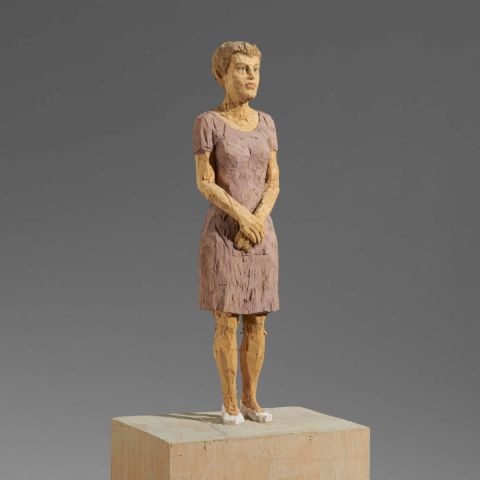
Lot 10 | August Macke | "Composition II" (Susanna im Bade)
1887 Meschede - 1914 Perthes-les-Hurlus
Title: "Composition II" (Susanna im Bade).
Date: 1913.
Technique: Watercolour and India ink on sketching paper.
Measurement: 23.5 x 25cm.
Notation: Inscribed, dated and titled verso bottom: Coloured ink Composition II 1913. Here additionally with artist's estate stamp (Lugt 1775b) with the documented number 29.
Frame/Pedestal: Craftman's frame.
Provenance:
- Dr. Fischer Collection, Stuttgart
- Roman Norbert Ketterer Art Gallery, Stuttgart, auction 29 November 1955, lot 1622
- Dallinger Collection
- Walter Bareiss Collection, New York
- Museum of Modern Art (donated by W. Bareiss, 1957)
- Private collection, South America/Germany
Exhibitions:
- Städtisches Kunsthaus Bielefeld, 1957
- Sala de Exposiciones Fundacion Eugenio Mendoza, Caracas 1959
Literature:
- Heiderich, Ursula: August Macke - Watercolours, Catalogue Raisonné, Ostfildern-Ruit 1997, cat. rais. no. 108, ill.
- Vriesen, Gustav: August Macke, Stuttgart 1957 (2nd edition), cat. no. 115, ill.
- Exhibition catalogue Macke. Watercolour Exhibition, Bielefeld Municipal Art Gallery, 1957, cat. no. 115, ill. p. 20
- Exhibition catalogue Expressionismo in Alemania, Sala de Exposiciones Fundacion Eugenio Mendoza, Caracas 1959, cat. no. 68
- August Macke: intellectual and artistic centre of the Rhenish Expressionists, member of Der Blaue Reiter
- Classical pictorial theme in a radically modern interpretation
- Harmonious composition with vibrant colours
"Ich habe alles, was ich brauche, und bin vollkommen glücklich, wenn ich malen kann, was ich fühle. ('I have everything I need and am perfectly happy when I can paint what I feel.')
(August Macke, 1911; quoted from: Ewers-Schultz, Ina: August Macke, Cologne 2015, p. 55.)
Artistic consolidation and formal clarification
August Macke is considered a precocious artist of German Expressionism and the epitome of a style of painting that combines joie de vivre, colour and modernity. As a member of the legendary artist group "Der Blaue Reiter" (The Blue Rider) and the intellectual centre of the Rhenish Expressionists, he was at the heart of an era that reinvented vision and painting. Influenced by the French avant-garde – he travelled to Paris in 1907, 1908 and 1912 – Macke developed his own distinctive visual language. His paintings continue to fascinate today with their colourful lightness, transforming the everyday into the poetic: people strolling, bright shop windows, harmonious landscapes and still lifes.
Although his life ended tragically early on the battlefields of the First World War, August Macke left behind a significant body of work of timeless radiance, which impressively demonstrates his central role in the development of modern painting.
In 1911, August Macke found himself at an important point in his development. At the beginning of the previous year, he had met Franz Marc in Munich, with whom he formed an artistically inspiring and supportive friendship. In November, he returned with his family from a long stay at Lake Tegernsee to his hometown of Bonn, where his studio was being expanded during the winter months.
At this stage in his artistic career, Macke was interested in further developing his painting techniques using traditional pictorial themes. His paintings were no longer mere representations of nature; rather, what he saw was combined into decorative, expressive paintings whose compelling visual impact was created by the absence of spatial representation and the exciting interplay of coloured surface.
Biblical motif in the language of modernism
Macke's watercolour painting "Susanna in the Bath" occupies a special place within his oeuvre as a traditional biblical motif. The starting point is the story of the chaste Susanna from the Book of Daniel, who is secretly observed by two elders while bathing and later unjustly accused of infidelity. At the centre of Macke's composition lies a naked female figure on a pink cloth, surrounded by bright blue tones of varying intensity and depth, creating an atmosphere of water, light and movement. Behind her, the faces of two older men appear as silhouettes, watching the young woman's naked body from behind cover.
In contrast to the traditional depiction of "Susanna at the Bath," Macke is less interested in the narrative or moral dimension of the subject matter, using the motif instead as an opportunity for a formal exploration of the harmony between colour, surface and figure. The female figure is not primarily an object of voyeuristic observation, but part of a compositional harmony, embedded in a network of brightly coloured surface forms. Macke thus removes the subject from its traditional context and translates it into the language of modernism.
Doris Hansmann
+49 221 92 58 62 304
Print this lot | Recommend lot |
Conditions of this Lot
32% buyer’s premium on the hammer price
Estimated shipping costs for this lot:
Arrangement after the auction.
August Macke Germany Modern Art 1910s Craftman's frame Woman Works on paper Watercolour Religious Theme
More lots which could be of your interest
- Estimate: 15.000 - 20.000 €
04.12.2025 - ca.10:14Modern | Post War | Contemporary | Galerie Thomas | The Jagdfeld Collection | Auction 03.12.2025 - Estimate: 25.000 - 35.000 €
04.12.2025 - ca.10:13Modern | Post War | Contemporary | Galerie Thomas | The Jagdfeld Collection | Auction 03.12.2025 - Estimate: 10.000 - 15.000 €
04.12.2025 - ca.10:15Modern | Post War | Contemporary | Galerie Thomas | The Jagdfeld Collection | Auction 03.12.2025 - Estimate: 10.000 - 15.000 €
04.12.2025 - ca.10:15Modern | Post War | Contemporary | Galerie Thomas | The Jagdfeld Collection | Auction 03.12.2025 - Estimate: 9.000 - 13.000 €
04.12.2025 - ca.10:16Modern | Post War | Contemporary | Galerie Thomas | The Jagdfeld Collection | Auction 03.12.2025













